Folktales, myths, legends, and fables are part of the rich body of stories from around the world. In this week’s column, two members of the International Reading Association’s Children’s Literature and Reading Special Interest Group review recently published collections of tales from specific cultures, countries, or world regions and retellings of individual tales in which a strong storytelling voice is evident in both the written text and any accompanying artwork. A collection of poems that present twists of popular Western fairy tales is also reviewed.
Mindful of the use of folklore in classrooms, the reviewers were interested in books that included commentary by the authors on their retellings and the sources of the stories. Many of these folktales are enjoyable for all ages; listed grade levels for some of the books could include “and up,” which fits with the history of traditional storytelling of old and young sharing stories together. The hope is that the reviews will encourage educators to include not only these books but also other traditional tales in their read-aloud sessions and in classroom libraries for independent reading. Use these books to explore with children universal themes that run through tales from different cultures and how authors and illustrators, in true storytelling fashion, have added their personal touches to them.
GRADES K-3
Divakaruni, Chitra Banerjee. (2013). Grandma and the great gourd: A Bengali folktale. Illus. by Susy Pilgrim Waters. New York, NY: Macmillan/Roaring Brook/Neal Porter Books.
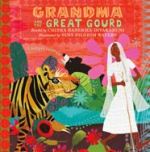 In traditional literature, characters and events frequently come in multiples and in this tale Grandma leaves her home and garden to the watchful eye of her two dogs, and on her journey through the jungle to visit her daughter, must contend with three carnivorous animals: a fox, a bear, and a tiger. Convincing the animals she will provide them a better meal upon her return, she survives her journey. During her visit, Grandma becomes plump as she told the animals she would be upon her return.
In traditional literature, characters and events frequently come in multiples and in this tale Grandma leaves her home and garden to the watchful eye of her two dogs, and on her journey through the jungle to visit her daughter, must contend with three carnivorous animals: a fox, a bear, and a tiger. Convincing the animals she will provide them a better meal upon her return, she survives her journey. During her visit, Grandma becomes plump as she told the animals she would be upon her return.
Because Grandma was worried about being eaten, her daughter sequestered her in a great gourd she sets to rolling through the jungle. Unknowingly, Grandma’s journey homeward is aided by the animals, who push the gourd along. Every line advances the story in this invigorating tale, and when the clever fox sees the ruse of the gourd, Grandma is in danger yet again. The quality of the bright illustrations rendered in a combination of media and technique perfectly demonstrates the nature of succinctly depicted characterization in folklore.
—Reviewed by Sandip Wilson, Associate Professor, Husson University, Maine
Pinkney, Jerry. (2013). The tortoise & the hare. Illus. by author. New York, NY: Little, Brown.
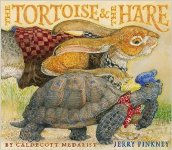 Pinkney has created an exquisite, nearly wordless retelling of the well-known Aesop fable about the race between the tortoise and the hare. After Fox starts the race with “On your marks, get set…Go!” the only other words in the book are those of the moral “Slow and steady wins the race,” with the words accumulating one word at a time on the double-page spreads of the book. As the speedy hare leaps ahead and confidently takes time out to dig his way under a fence to eat lettuce and then nap, the persevering tortoise overcomes numerous obstacles along the racecourse through the American Southwest desert.
Pinkney has created an exquisite, nearly wordless retelling of the well-known Aesop fable about the race between the tortoise and the hare. After Fox starts the race with “On your marks, get set…Go!” the only other words in the book are those of the moral “Slow and steady wins the race,” with the words accumulating one word at a time on the double-page spreads of the book. As the speedy hare leaps ahead and confidently takes time out to dig his way under a fence to eat lettuce and then nap, the persevering tortoise overcomes numerous obstacles along the racecourse through the American Southwest desert.
Details of the race are revealed in Pinkney’s signature mixed-media illustrations. Pinkney uses every part of the book in retelling the fable. The book jacket illustration, which spreads across the front and back, introduces the setting for the race and the contenders. The front endpaper shows the race route and the back endpaper the end-of-race celebration. Pinkney adds endnotes about his personal connection to the tale, his choice of the American Southwest as the setting, and his creative process.
—Reviewed by Carolyn Angus, Children’s Literature Specialist, California
GRADES 4-6
Goldman, Judy. (2013). Whiskers, tails & wings: Animal folktales from Mexico. Illus. by Fabricio VandenBroek. 58 pp. Watertown, MA: Charlesbridge.
 This collection of tales is organized by the region of Mexico where they originated. Each tale is accompanied by an expository section explaining the cultural practices of the people whose tale is retold and a glossary of terms (some terms are Spanish, but many are in the language of the particular culture). Some selections are creation stories such as the Seri tale of how land was formed from the efforts of the sea turtle, who managed to bring sand from the depths of the sea that the god of creation could use to fashion beaches, deserts, and the mountains. The sea turtle is the center of the culture of the Seri people, who, Goldman explains, protect sea turtles and eggs, making sure the hatchlings reach the sea.
This collection of tales is organized by the region of Mexico where they originated. Each tale is accompanied by an expository section explaining the cultural practices of the people whose tale is retold and a glossary of terms (some terms are Spanish, but many are in the language of the particular culture). Some selections are creation stories such as the Seri tale of how land was formed from the efforts of the sea turtle, who managed to bring sand from the depths of the sea that the god of creation could use to fashion beaches, deserts, and the mountains. The sea turtle is the center of the culture of the Seri people, who, Goldman explains, protect sea turtles and eggs, making sure the hatchlings reach the sea.
Other tales, what might be called pourquoi tales, explain natural phenomena such as the tale of why Señor Grillo, who outsmarts Señor Puma, has come to sing his song every night. VandenBroek’s illustrations, in warm, earthy hues, are done in acrylics and watercolors on texturized paper. Goldman has included a general annotated bibliography, which includes many electronic sources; web resources; and tale sources organized by culture as they are introduced in the book; and an index.
—Reviewed by Sandip Wilson, Associate Professor, Husson University, Maine
Nunes, Shiho. S. (2013). Chinese fables: “The dragon slayer” and other
timeless tales of wisdom. Illus. by Lak-Khee Tay-Audouard. 66 pp. Rutland, VT: Periplus Editions/Tuttle.
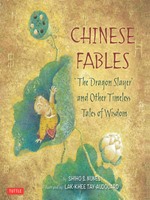 In the introduction to this anthology of nineteen tales, Nunes explains, “In China, cautionary talks, like fables and parables…are part of a class of works called yu-yen, writings with an underlying—second—meaning” (p. 5). She says their origins date from 500 BCE to the middle of the 17th century. Some of them such as the “King of Beasts” reflect the trickster tale. In this story the preyed upon fox outwits the lion. In “Cooking the Duck” two brothers, while fighting over how they will cook two ducks they have caught, let them escape.
In the introduction to this anthology of nineteen tales, Nunes explains, “In China, cautionary talks, like fables and parables…are part of a class of works called yu-yen, writings with an underlying—second—meaning” (p. 5). She says their origins date from 500 BCE to the middle of the 17th century. Some of them such as the “King of Beasts” reflect the trickster tale. In this story the preyed upon fox outwits the lion. In “Cooking the Duck” two brothers, while fighting over how they will cook two ducks they have caught, let them escape.
Other tales such as “Stealing the Bell” have a different quality. In the tale, foolish Ch’in, concerned about plundering in the besieged city in which he lives, decides to save the ancient bronze bell. To move such a heavy artifact, however, he has to break it into pieces with a sledgehammer. Fearing everyone will hear the noise, he stuffs his ears with rags to muffle the sound. Many of the tales reflect philosophical traditions such as those featuring Sakyamuni, Lao-Tse, and Kwan-Yin. The tales have a humorous quality amplified by illustrations rendered in ink wash and pencil on bamboo rag paper in a style reminiscent of Chinese painting, with characters’ gestures simply yet richly depicted.
—Reviewed by Sandip Wilson, Associate Professor, Husson University, Maine
Scott, Nathan Kumar. (2012). The Great Race: An Indonesian trickster tale. Illus. by Jagdish Chitara. London, UK: Tara Books.
 Small but speedy Kanchil the mouse deer confidently challenges any animal to The Great Race to determine the fastest animal in the forest. As Kakatua the scarlet macaw broadcasts news of the race, animals gather to watch, but only tiny Pelan the snail accepts the challenge to race from the big tree by the riverbank to the waterfall. Along the route, Kanchil stops to rest, eat grass, and takes a long drink from the river. When Kanchil reaches the waterfall, Pelan is already there.
Small but speedy Kanchil the mouse deer confidently challenges any animal to The Great Race to determine the fastest animal in the forest. As Kakatua the scarlet macaw broadcasts news of the race, animals gather to watch, but only tiny Pelan the snail accepts the challenge to race from the big tree by the riverbank to the waterfall. Along the route, Kanchil stops to rest, eat grass, and takes a long drink from the river. When Kanchil reaches the waterfall, Pelan is already there.
In a rematch along the reverse route, Pelan wins again. How did Pelan beat Kanchil not once but twice? With a turn of the page, readers can figure it out when they see Pelan and his twin brother pictured side by side. A note identifies Kanchil as a trickster from Indonesian and Malaysian folklore. Because of his small size, the mouse deer must use his wits to survive. In this tale, however, as is true of trickster tales from other cultures, the trickster learns a lesson from an animal that has outwitted him. An endnote provides information about the intricately detailed illustrations done in the ancient style of sacred textile art called Mata Ni Pachedi.
—Reviewed by Carolyn Angus, Children’s Literature Specialist, California
Williams, Marcia. (2012). The elephant’s friend and other tales from ancient India. Illus. by author. Somerville, MA: Candlewick Press.
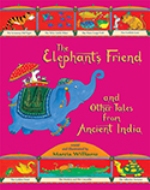 Williams retells and illustrates in her colorful and humorous comic-strip style eight folktales taken from three classic collections from ancient India: Hitopadesha Tales, Jataka Tales, and Panchatantra Tales. The narration runs along the base of the panels, which feature animated characters, who contribute quips in balloon dialogue. Details of each tale are presented on intricately patterned backgrounds. Characters such as the tortoise in “The Talkative Tale” may also appear in the decorative border of a tale and have more to say. Bit players kibitz as well, so there are more details to be discovered with each rereading of these entertaining tales of ancient India, which convey gentle lessons that are universal.
Williams retells and illustrates in her colorful and humorous comic-strip style eight folktales taken from three classic collections from ancient India: Hitopadesha Tales, Jataka Tales, and Panchatantra Tales. The narration runs along the base of the panels, which feature animated characters, who contribute quips in balloon dialogue. Details of each tale are presented on intricately patterned backgrounds. Characters such as the tortoise in “The Talkative Tale” may also appear in the decorative border of a tale and have more to say. Bit players kibitz as well, so there are more details to be discovered with each rereading of these entertaining tales of ancient India, which convey gentle lessons that are universal.
—Reviewed by Carolyn Angus, Children’s Literature Specialist, California
Yolen, Jane, & Dotlich, Rebecca Kai. (2013). Grumbles from the forest: Fairy-tale voices with a twist. Illus. by Matt Mahurin. 40 pp. Honesdale, PA: Highlights/WordSong.
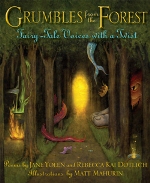 Pairs of poems add fresh voices to each of fifteen well-known Western fairy tales. For some of the tales, two characters speak and what they have to say changes the story, as is the case of “The Frog Prince” in which the enchanted frog and the princess speak. For other tales, one character expresses different points of view as in the pairing of “Snow White Makes a Plea to the Witch” and “Snow Speaks to the Mirror.”
Pairs of poems add fresh voices to each of fifteen well-known Western fairy tales. For some of the tales, two characters speak and what they have to say changes the story, as is the case of “The Frog Prince” in which the enchanted frog and the princess speak. For other tales, one character expresses different points of view as in the pairing of “Snow White Makes a Plea to the Witch” and “Snow Speaks to the Mirror.”
Other twists in a tale occur when an unexpected voice is heard such as that of the pea in “The Princess in the Pea,” who says it is unhappy about being removed from its pod and stuck under the mattresses. Even different poetic forms are used as in the pairing of “Thumbelina: A Cinquain” and “Little Bit: A Haiku.” Young readers will be drawn to this book by the catchy title and the eerie surrealistic cover illustration. After they have read the book, they may want to take up the challenge made in an introductory letter from the author to try writing a fairy-tale poem. Brief notes about the fifteen fairy tales and Internet resources are appended.
—Reviewed by Carolyn Angus, Children’s Literature Specialist, California
GRADES 7-8
Ehrlich, Amy. (2013). With a mighty hand: The story in the Torah. Illus. by Daniel Nevins. 198 pp. Somerville, MA: Candlewick Press.
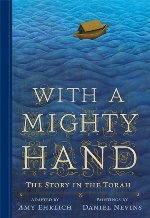 The five books of the Hebrew Bible are the structure of the stories, beginning with Adam and Eve. They recount the lives of patriarchs and the generations of sons and their families and retell stories of the Great Flood, the Passover and Exodus, the long period in the desert, and Moses’s lessons for the Israelites. Distinctive features of the book include a map showing the regions and cities mentioned in the book, a table of contents organized by the five books of the Torah, and notes in the back matter on the particular verses included in the stories. A Torah genealogy shows the condensed sense of time indicative of traditional literature in its reference to seven generations that pass between Seth, the son of Adam and Eve, and Noah, and eight more generations that pass between his son and Abraham.
The five books of the Hebrew Bible are the structure of the stories, beginning with Adam and Eve. They recount the lives of patriarchs and the generations of sons and their families and retell stories of the Great Flood, the Passover and Exodus, the long period in the desert, and Moses’s lessons for the Israelites. Distinctive features of the book include a map showing the regions and cities mentioned in the book, a table of contents organized by the five books of the Torah, and notes in the back matter on the particular verses included in the stories. A Torah genealogy shows the condensed sense of time indicative of traditional literature in its reference to seven generations that pass between Seth, the son of Adam and Eve, and Noah, and eight more generations that pass between his son and Abraham.
Full-page illustrations painted in oil on wood accompany each story. In her introduction Goldman explains that although the stories occurred between 2000 and 1250 BCE, they were not recorded until much later, between about 900 BCE to 450 BCE.
—Reviewed by Sandip Wilson, Associate Professor, Husson University, Maine
Munduruku, Daniel. (2013). Amazonia: Indigenous tales from Brazil. Trans.
by Jane Springer. Illus. by Nikolai Popov. 95 pp. Toronto, ON: House
of Anansi/Groundwood Books.
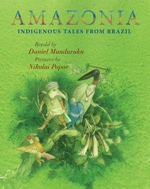 Munduruku, a well-known indigenous Brazilian author, retells twelve myths and legends from eight groups of indigenous people from the Amazon region, selected from an out-of-print Russian anthology of Brazilian folktales, Myths, Fairytales and Legends of Brazil, compiled by E. Ogeva (1987). Talking animals and magical creatures interact with humans in a variety of experiences, some involving living in harmony with others and the natural world and others involving clashes that may be transformative or deadly. For example, a gluttonous boy becomes a parrot in “The Parrot Who Sings Kra-Kra-Kra” and the human wife of a jaguar is killed by the giant Marugodo caterpillar when she fails to heed her husband’s warning not to laugh while he is out hunting in “The Brothers Bacororo and Itubore.” The style of storytelling as well as characters and settings will seem unusual to children familiar primarily with European folklore, but as Munduruku discusses in his introduction, the stories in Amazonia “remind us of the importance of bringing together humankind…” (p.9).
Munduruku, a well-known indigenous Brazilian author, retells twelve myths and legends from eight groups of indigenous people from the Amazon region, selected from an out-of-print Russian anthology of Brazilian folktales, Myths, Fairytales and Legends of Brazil, compiled by E. Ogeva (1987). Talking animals and magical creatures interact with humans in a variety of experiences, some involving living in harmony with others and the natural world and others involving clashes that may be transformative or deadly. For example, a gluttonous boy becomes a parrot in “The Parrot Who Sings Kra-Kra-Kra” and the human wife of a jaguar is killed by the giant Marugodo caterpillar when she fails to heed her husband’s warning not to laugh while he is out hunting in “The Brothers Bacororo and Itubore.” The style of storytelling as well as characters and settings will seem unusual to children familiar primarily with European folklore, but as Munduruku discusses in his introduction, the stories in Amazonia “remind us of the importance of bringing together humankind…” (p.9).
A glossary provides descriptions of the animals and plants in the tales. The full-page gouache and India ink paintings by Russian artist Popov, which originally illustrated E. Ogeva’s Myths, Fairytales and Legends of Brazil, are as intriguing as the tales themselves.
—Reviewed by Carolyn Angus, Children’s Literature Specialist, California
GRADES 9-12
Pullman, Philip. (2012). Fairy tales from the Brothers Grimm: A new English version. 406 pp. New York, NY: Penguin/Viking.
 Pullman’s notes that conclude each selection are a distinctive feature of this collection of fifty stories from the Brothers Grimm. He comments on their oral and literary sources, other collections in which they occur such as Italian and earlier British editions, the language in which they were originally written, the changes in details of the stories from one edition of the Grimms’ stories to another, and cultural or historical references such as the conditions of the forests of Germany in the 17th to 19th centuries in his accounting for the huntsman character in “Little Red Riding Hood.”
Pullman’s notes that conclude each selection are a distinctive feature of this collection of fifty stories from the Brothers Grimm. He comments on their oral and literary sources, other collections in which they occur such as Italian and earlier British editions, the language in which they were originally written, the changes in details of the stories from one edition of the Grimms’ stories to another, and cultural or historical references such as the conditions of the forests of Germany in the 17th to 19th centuries in his accounting for the huntsman character in “Little Red Riding Hood.”
Pullman has included versions of some stories by virtue of their being well known such as “Snow White” and “Cinderella,” yet he argues that other stories better illustrate the musical rhythm and repetition of the language in selections such as “The Juniper Tree,” “Fisherman and His Wife,” and the “Three Snake Leaves.” Other stories such as “Jorinda and Joringel” Pullman says combine the folktale style of storytelling with the later romantic style that appeared in narrative. Pullman makes all the stories fresh and in his notes he explains his decisions in retelling them.
The introduction gives an overview of the genre and Pullman explains that the Grimm brothers, who were associated with colleagues and others with a growing interest in folklore, received multiple versions over the decades of the publication of their books. The conversational tone of Pullman’s voice, which is clear from the introduction through all the notes, contributes to the storytelling in these pages. The collection includes references to which Pullman has cited throughout his notes.
—Reviewed by Sandip Wilson, Associate Professor, Husson University, Maine
These reviews are submitted by members of the International Reading Association's Children's Literature and Reading Special Interest Group (CL/R SIG) and are published weekly on Reading Today Online.